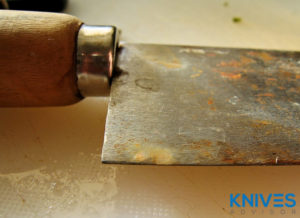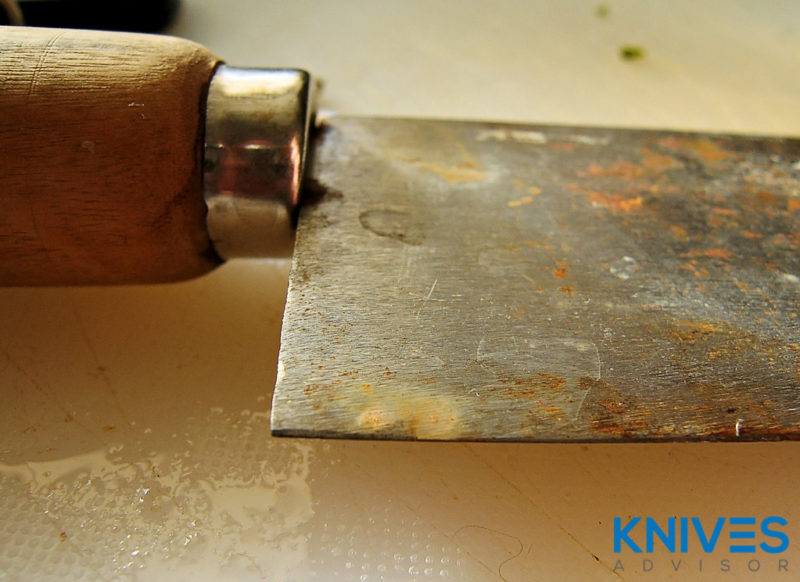
When choosing kitchen knives, the main choice of blade material is carbon steel or stainless steel. There are pros and cons to each to each of these materials.
One of the biggest downfalls of carbon steel knives is that they are prone to developing rust spots and this is something that does not happen if you opt for stainless steel knives.
However, this does not mean that you should dismiss carbon steel knives as an option as they have many plus points. They are often sharper, retain their edge for longer, and are easier to sharpen. You should not allow the potential of rust formation deter you from choosing carbon steel knives as this is something you can prevent and remedy.
Here are some tips on how to prevent rust on carbon steel kitchen knives. We also touch on how to treat and remove rust formation that has already occurred on your carbon steel knives.
Why Does Rust Form on Knives?
Steel is basically an alloy of iron and carbon. The addition of a small amount of carbon adds strength to the iron. When exposed to oxygen, iron undergoes an oxidation-reduction reaction which creates iron oxide, which is known as rust. The rust creates a rough surface which increases the surface area for a reaction with oxygen, thus creating more rust.
Therefore, rust spreads quickly once it has begun to form. If you don’t tackle the issue, a deep pit will develop in your knife.
Why Are Carbon Steel Kitchen Knives More Prone to Rust Than Ones Made from Stainless Steel?
Although all steel knives are an alloy of iron and carbon, stainless steel knives also contain chromium. This makes stainless steel knives resistant to stains and rust. However, even stainless steel knives will get rust if they are not cared for properly; they are simply less likely to develop rust than carbon steel kitchen knives.
How to Prevent Rust Formation on Your Knives?
Taking proper care of your carbon steel kitchen knives can reduce the likelihood of them developing rust. The following tips will help you to prevent rust from forming on your knives:
- Keep them clean and dry– The most important point is to keep your carbon steel knives clean and dry. As soon as you have finished using them, wash them and dry them thoroughly using a soft, dry cloth.
- Build a patina-A patina is a formation of a more stable form of iron oxide called black iron oxide. When you cut different ingredients, you will see various colors form on your knife. All colors are good except red and orange. This is how your knife reacts to different ingredients and the formation of these colors is good as it prevents rust formation. Soaking your knives in blood or cutting lots of meat will create a good patina, as will potatoes. Plantain skin contains a substance called tannic acid. This is the same ingredient that is used in commercial rust converte Therefore, cutting through plantain skin is a good way of building a patina and preventing rust formation.
- Oil your knives– Even if you have dried your knives thoroughly, they are still affected by water if you keep them in an area with damp or humidity. A kitchen filled with steam will soon create a humid environment that your knives will not like. A solution to this is to treat your knives with a little oil before putting them away as this creates a layer that water will not penetrate. However, you should not use just any oil to do this. The best option is to buy Tsubaki oil, which is available in both specialty knife shops and from online retailers.
- Avoid acids– Some of the ingredients you cut will increase the chances of rust forming on your knives, especially those with a high acid content. If you prepare acidic ingredients, then you should rinse and dry your knife immediately. Another trick that helps to reduce the likelihood of a reaction is to create a slurry of baking soda and rub your knife down with this.
- Treat it quickly– Once rust has formed, you need to treat it quickly to prevent the situation becoming worse.
How to Remove Rust on Your Carbon Steel Knives?
If your carbon steel knives do develop rust, then it is not the end of their usefulness and you do not need to throw them away. There are several ways that you can remedy the situation. Some of these include the following:
- Cleaning– Before using any method of removing rust from your knives, you should give them a thorough clean first. Similarly, once you have removed rust, you should wash and dry them again.
- Baking soda– You can make a paste with baking soda and scrub the paste onto the blades of your knives using a toothbrush. Do not scrub too hard as baking soda and the bristles of a toothbrush are abrasive and this can scratch the surface of your knife.
- Steel wool– If your knives are very rusty, you can attempt to remove the rust using steel wool. Alternatively, use an abrasive sponge in the same way.
- Vinegar bath– Soak the blades of your knives in a pan of white vinegar, or soak kitchen paper in the white vinegar and wrap around your knife blade. Wipe down the blade to remove the rust.
- Sandpaper and WD40– Spray a little WD40 on the affected parts of the blade and then sand using a fine sandpaper, such as WD40.
- Rich soil– If you want to use a natural method of removing rust from carbon steel knives, you can try thrusting the blades into rich soil about a dozen times and then wiping clean.
- The potato or onion methods– Another natural method to use is to stick the blade into either a potato or onion so that the rusty part is covered. Leave to stand for a few hours before removing the blade from the potato or onion and then wiping clean.
Bottom Line
In this article, we touched briefly on how to prevent rust formation on carbon steel kitchen knives. Although carbon steel kitchen knives are prone to getting rust spots, this does not mean you should dismiss them as a good option. They have many benefits and are the preferred choice of many professional and celebrity chefs.
If you do opt for carbon steel kitchen knives, then you need to take good care of them and use preventative measures to reduce the likelihood of them developing rust. When the knives do develop rust there are many methods you can use to remove the rust from the blades easily.
Two types of steel commonly used for high-end knives include S30v and 420HC. Read more about the differences between these two types here.
